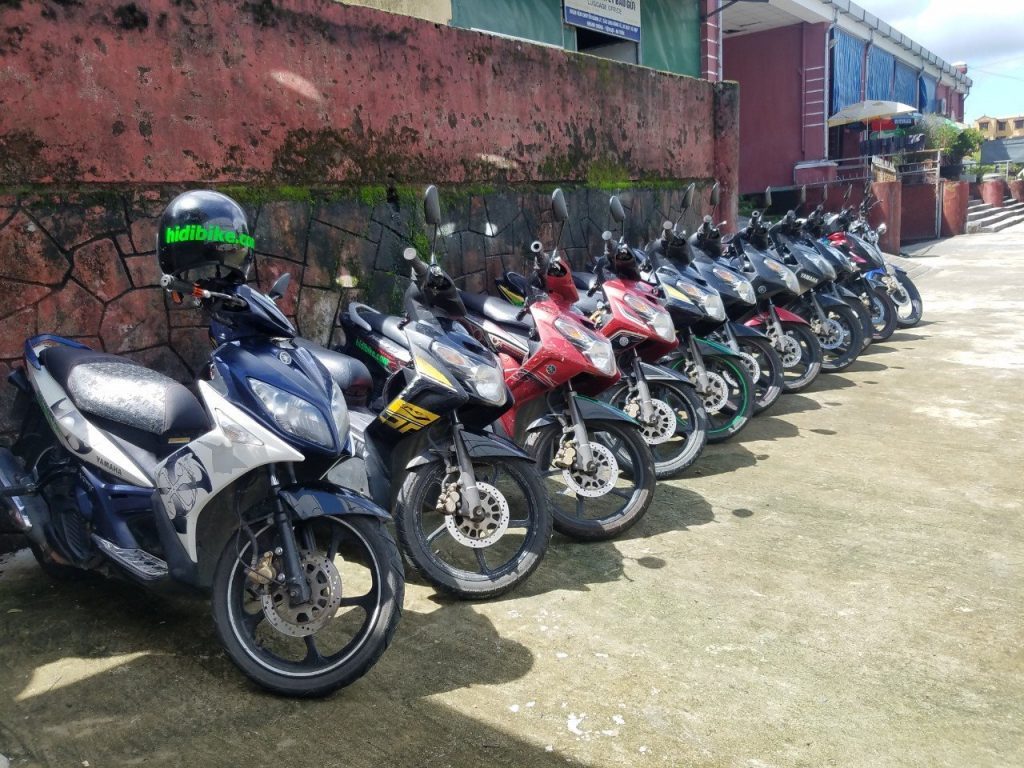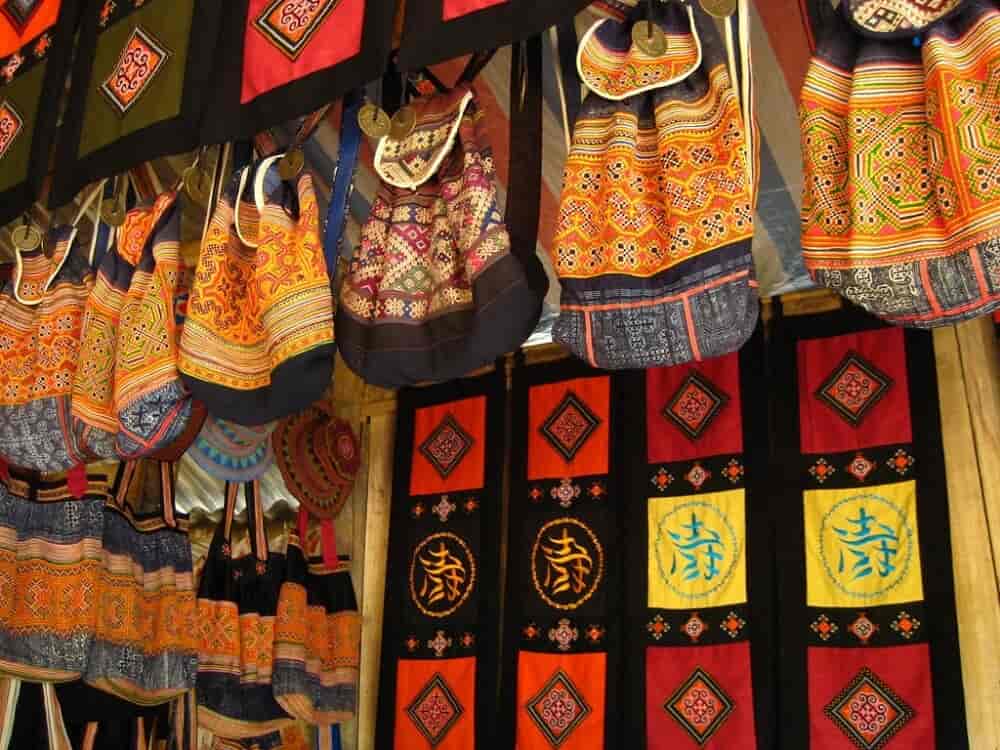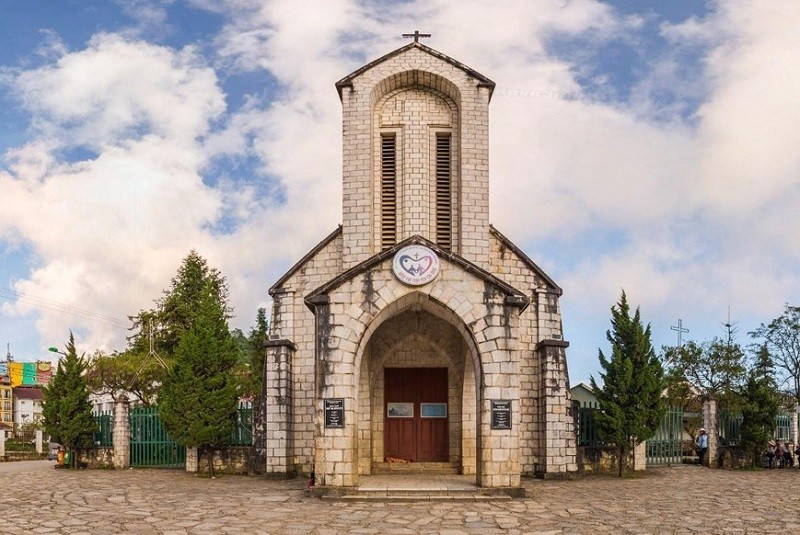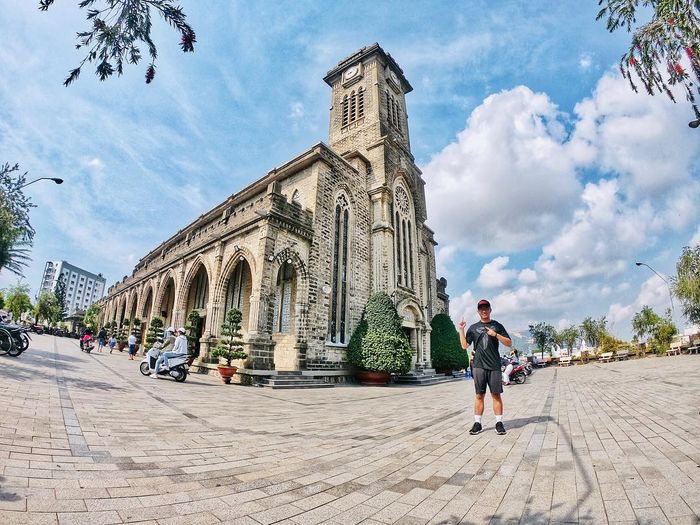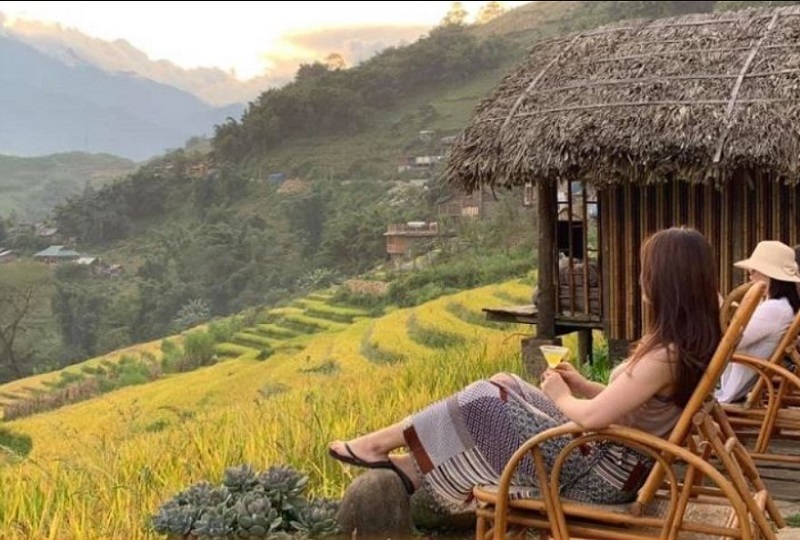Sapa is a land that attracts many tourists, both domestic and international, with its fresh climate and beautiful scenery, as well as the warm hospitality of the local people. No one will forget these beautiful images in Sapa. Explore the most beloved tourist attractions in Sapa with DanangPrivateCar.com!
20+ Unmissable Beautiful Tourist Attractions in Sapa
Sapa boasts numerous famous tourist spots with unique and captivating features. Let’s explore the beauty of this place with more than 20 tourist attractions in Sapa that you shouldn’t miss on your trip.
Fansipan Peak – Roof of Indochina
When people set foot in Sapa, they all aspire to conquer the Roof of Indochina, which stands proudly at an altitude of 3,143 meters, making it the highest peak in the three Indochinese countries (Vietnam, Laos, Cambodia).
To reach the summit, there are two options: trekking or taking the cable car. Since 2016, the Sunworld group has constructed the world’s longest cable car system to make conquering Fansipan easier. From Sun Plaza, you can use the Mường Hoa mountain train to reach Hoàng Liên station in approximately 15 minutes. Sitting in the cabin, you’ll arrive at Fansipan cable car station. During the journey, you can marvel at the breathtaking scenery of Muong Hoa Valley and the lush green mountains.

Fansipan Mountain is beautiful in every season; each season brings different charms. In spring, you can admire the blooming flowers, including rhododendrons, sunflowers, and buckwheat flowers. In summer, you can escape the scorching heat and enjoy the fresh air. Autumn offers the opportunity to gaze at the clouds in the sky, while winter, if you’re lucky, allows you to witness the snow-covered peak of the Roof of Indochina. Hence, Fansipan is enchanting throughout the year.
- Cable car ticket to Fansipan: 700,000 VND/adult, 550,000 VND/child.
Stone Church of Sapa
The Stone Church of Sapa is situated in the heart of Sapa town and is a must-visit tourist destination. Constructed in the early 1990s, this church boasts a serene beauty and unique architecture amidst the bustling town. It serves as a meeting place for local youth, especially during the winter season when the church is adorned with sparkling Christmas lights and hosts festive celebrations, including Sapa’s splendid festivals.

Cat Cat Village
Many tourists jest, “If you haven’t been to Cat Cat Village, you haven’t truly visited Sapa.” This place is like the heart of the misty land, nestled amidst the great mountains and forests. Cat Cat Village exudes simplicity, with traditional stilt houses lining the winding streams. It is mainly inhabited by the H’Mong people, and visiting here allows you to immerse yourself in the daily activities of the locals.

Located just 2 km from the town center, Cat Cat Village is easily accessible. As you enter, you’ll be impressed by the stone-paved paths flanked by local stalls selling souvenirs and gifts. The highlight is the Hoang Lien Cultural House, painted in vibrant yellow. Descending into the village, you’ll be captivated by the beauty of Tien Sa waterfall, wooden bridges, and giant water wheels – all perfect spots for beautiful and captivating photographs.
Entrance fee to Cat Cat Village: 90,000 VND/ticket.
Ham Rong Mountain (Nui Ham Rong)
Situated right behind Sapa Stone Church, Ham Rong Mountain is a place where you can indulge in outdoor rock climbing. With a height of less than 2000 meters, it’s relatively easy to conquer its peak.

Dragon’s Jaw Mountain is adorned with various exotic flowers and characteristic plants of the Sapa mountainous region. Standing atop the mountain, you can observe the panoramic view of Sapa town.
- Ticket price for Dragon’s Jaw Mountain: 70,000 VND/ticket.
Rose Valley (Thung Lung Hoa Hong)
Named after the numerous roses it houses, including wild roses, climbing roses, and imported European roses, Rose Valley is a perfect destination for couples. It feels like stepping into a fairy tale, surrounded by vibrant roses that dispel the chilly atmosphere of the misty land. This place is a picturesque location, reminiscent of the stories of Snow White. The radiant roses illuminate the otherwise foggy atmosphere, making it a sight worth witnessing in person.

Entrance fee: 70,000 VND/ticket.
Silver Waterfall (Bac Waterfall)
Bac Waterfall, a majestic cascade amidst the grand Northwest mountains, is nature’s gift to Sapa. The gushing white waters flow down the lush green hills, providing a symphony of sounds – the melody of rushing water and the songs of chirping birds. Visiting here, you can immerse yourself in the embrace of Mother Nature, leaving behind the hustle and bustle of daily life to experience the tranquility of the Northwest forests.

- Ticket price: 20,000 VND/ticket.
Muong Hoa Valley
For Sapa enthusiasts, Muong Hoa Valley is a familiar name. Following a small pass from the town, you’ll be mesmerized by the picturesque scenery. Muong Hoa Valley contributes significantly to Fansipan exploration, allowing you to witness the beauty of terraced fields. In the summer, the valley comes to life with the vibrant green color of the growing rice.

Moana Scenery
When mentioning Moana Scenery in Sapa, many tourists are thrilled. This scenic spot was constructed a few years ago and resembles an outdoor studio. It is a perfect tourist destination for capturing stunning photos. Notable features include the Moana girl statue, Bali gate, infinity pool, golden hand, and a coffee area where you can relax after a photoshoot.
- Ticket price: 100,000 VND/ticket.
Ancient Ta Phin Monastery
If you seek a unique yet nostalgic space, Ta Phin Monastery is an ideal choice. This place used to be the residence of 12 nuns and played a part in Vietnam’s agricultural development in the past. The monastery’s architecture exudes an ancient charm, reminiscent of old European houses. Its vintage, desolate appearance attracts many tourists for exploration and photography.

Love Waterfall – Golden Stream (Thac Tinh Yeu – Suoi Vang)
Love Waterfall is located in San Sa Ho, Sapa district. If Silver Waterfall showcases the grandeur of the Northwest mountains, Love Waterfall embodies gentle beauty, resembling its name, “Love Waterfall.” The water flows down like giant white hats, creating a romantic atmosphere. On the way to Love Waterfall, you can also admire the beauty of “Golden Stream.” The stones in the stream reflect the sunlight, making the stream appear golden. Hence, it is named “Golden Stream.”

Since it is deep in the pristine forest of Hoàng Liên National Park, it is advisable to visit Love Waterfall in the morning or around noon. Avoid traveling there in the late afternoon or evening to ensure safety.
- Ticket price: 75,000 VND/ticket.
Sapa Love Market
Sapa Love Market is a local cultural event in this region, where numerous young men and women from the area gather. The market usually takes place every Saturday evening and serves as a platform for young men to showcase their talents to the girls they secretly admire. The melodious songs and leaf trumpets add to the lively atmosphere of the Love Market.

The Sapa Love Market also offers an opportunity for young couples to meet and socialize away from their parents’ watchful eyes. If you happen to visit Sapa during one of these Love Market events, consider yourself fortunate, as it will provide you with a deeper understanding of the local culture.
Y Linh Ho Village
Stepping away from the hustle and bustle of Sapa town, Y Linh Ho Village offers tranquility. Instead of the noisy traffic, you’ll encounter winding roads in this village. Y Linh Ho provides a peaceful atmosphere, making it an ideal place for trekking and enjoying the serene surroundings.
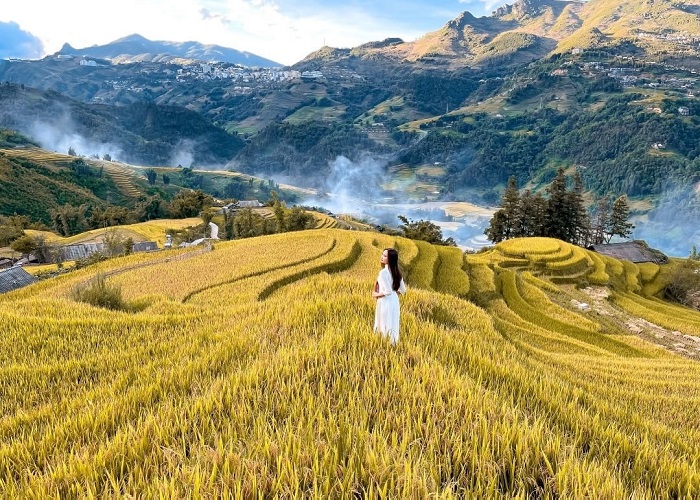
O Quy Ho Pass
O Quy Ho Pass is dubbed as one of the four great mountain passes in Vietnam, located on National Highway 4D cutting across the majestic Hoang Lien Son mountain range. It serves as a connection between the two provinces of Lao Cai and Lai Chau, offering breathtaking views of both regions.

Ta Van Village – Lao Chai
Ta Van Village is a communal residence for various ethnic minority groups such as H’Mong, Tay, Dao, and others. This beautiful village is located about 7 km from the town, making it accessible after exploring Cat Cat village. Here, you can admire terraced rice fields, especially during the ripe golden season. Ta Van Lao Chai becomes a gathering place for many photographers, both local and international, to capture the beauty of the golden rice fields.
Ta Phin Village
While Cat Cat village is primarily inhabited by H’Mong people, Ta Phin Village is home to the Red Dao ethnic group. It showcases unique and distinctive cultural traits along with traditional herbal remedies used by the Red Dao people. A visit to Ta Phin promises an intriguing and enriching experience, allowing you to explore their cultural heritage and even participate in activities such as traditional herbal baths, a practice for which the village is renowned.
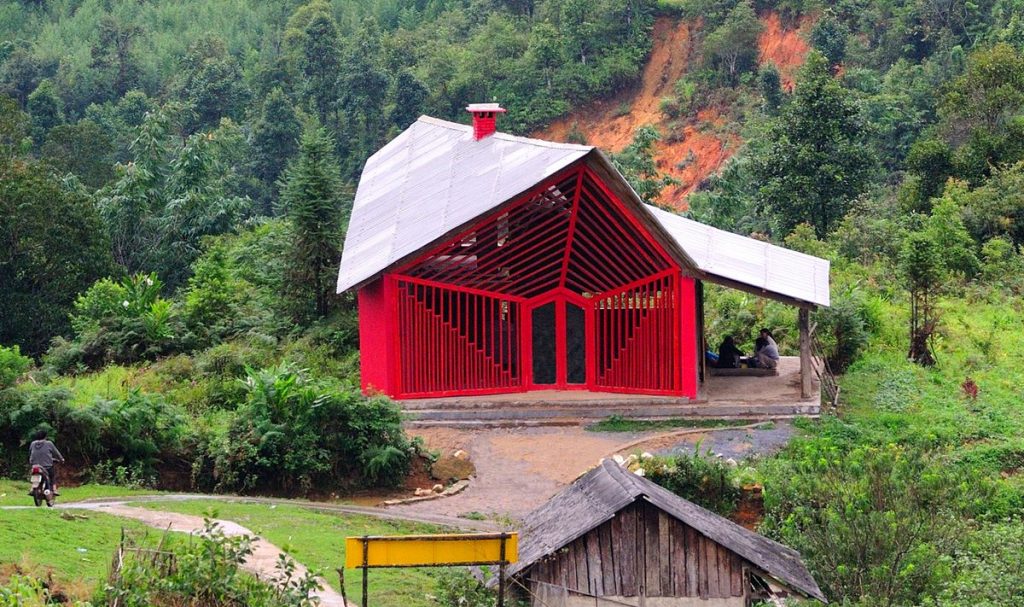
Cloud Bridge (May Bridge)
The Cloud Bridge, located at a distance from Sapa town, beckons young travelers with its picturesque setting. Simply a bridge spanning the Muong Hoa stream, it has become a hotspot for travelers seeking captivating photo opportunities. During winter, the bridge becomes even more enchanting as mist envelops the surroundings, creating a mysterious yet magical atmosphere, perfect for capturing ethereal photographs.
Dragon Cloud Glass Bridge
The Dragon Cloud Glass Bridge is currently considered Vietnam’s highest glass bridge, situated approximately 17 km from Sapa town. This adventure tourism site features two main attractions: a transparent elevator and the glass bridge. The elevator takes visitors to the 2200m-high glass bridge, where they can experience the sensation of floating among the distant mountains, including the O Quy Ho Pass. In addition to admiring the surrounding scenery, visitors can engage in various adventure activities such as mountain climbing, Bungee jumping, Zipline sliding, parachuting, and rock climbing. Please exercise caution and assess your readiness before participating in these adventure activities.
- Ticket Price: 400,000 VND/adult, 200,000 VND/child (excluding adventure activities).
Ha Khau Border Crossing
Believe it or not, during your Sapa journey, you have the opportunity to “travel abroad” after your relaxing vacation in Sapa. Allocate a day to visit Ha Khau Border Crossing, which marks the border between Vietnam and China. You can easily cross over by obtaining a border crossing permit, which costs approximately 200,000 – 300,000 VND per person.
At Ha Khau, indulge in a variety of dishes from this Chinese region, including skewered meats, bubble tea, and traditional steamed buns. Moreover, the light park in Ha Khau provides a beautiful backdrop for your photos, resembling scenes from ancient Chinese period dramas.
Sapa Heaven’s Gate
To conquer Sapa Heaven’s Gate, travelers must navigate long and winding roads. However, the effort is rewarded with a panoramic view that feels akin to touching the sky. Standing at Heaven’s Gate, you can overlook the majestic valley, the lush terraced fields, and in the distance, the Silver Waterfall, creating a scene of natural wonder that leaves you in awe. You can even feel the gusts of wind and occasionally hear the whispering breezes. The best times to visit Heaven’s Gate are early in the morning to witness the sunrise or in the evening to enjoy the twilight.
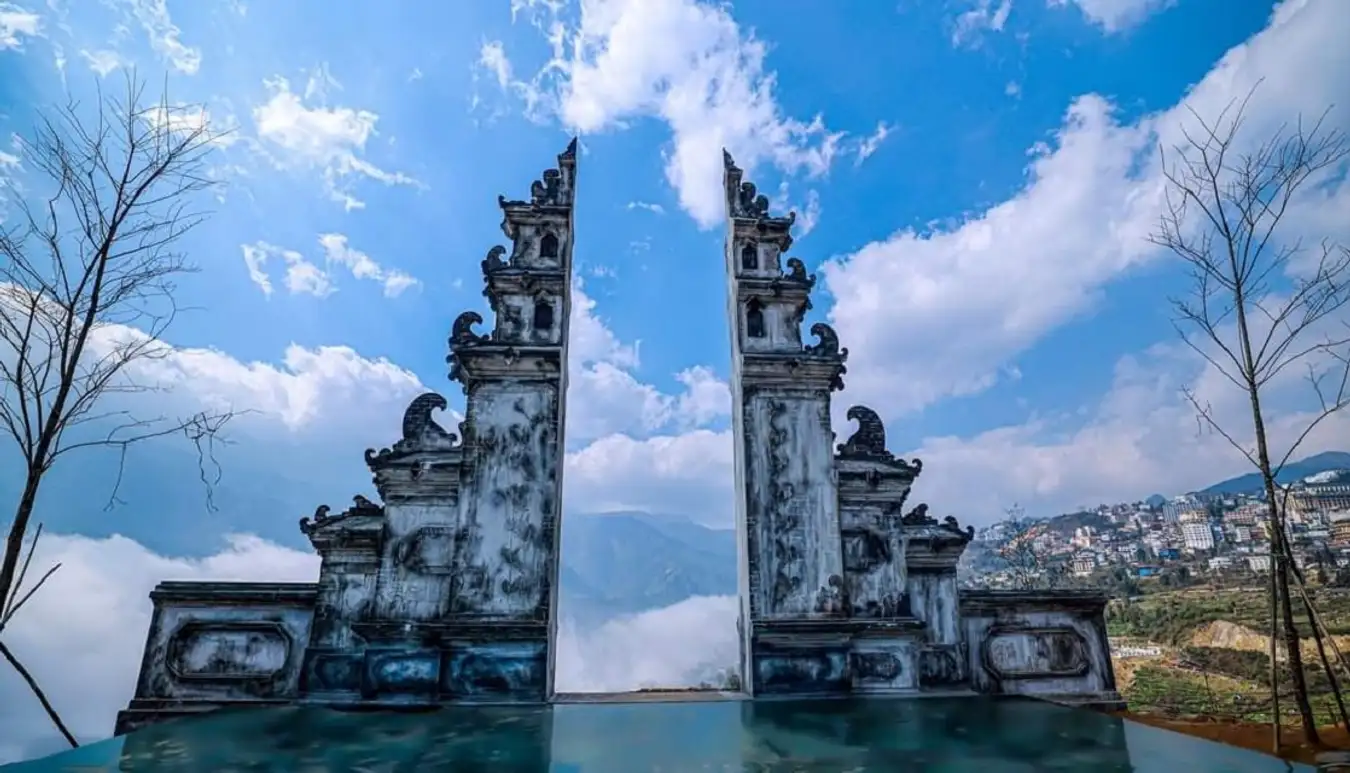
Additionally, two large walls have been constructed here. On misty days, standing between these walls gives you the sensation of standing at the threshold of heaven.
Ancient Rock Field (Bai Da Co)
Sapa’s Ancient Rock Field is an archaeological site located in the Muong Hoa Valley. It features numerous engraved rocks and ancient symbols scattered across the lush green meadows. These rocks are seen as mysterious messages left by ancestors for future generations.
The Ancient Rock Field comprises 159 large and small stones, each adorned with various enigmatic patterns. The carvings depict human figures, pathways, staircases, and writings, among others. Many of these carvings remain unexplained, adding to the site’s air of mystery. Symbols like the sun, representing vitality, and other sculptures on these stones convey messages from ancient times.
The Ancient Rock Field serves as a colossal museum set against the sky, where tourists can easily observe and appreciate the beauty of these engraved rocks. It is a popular destination for tourists, offering excellent opportunities for memorable photographs during their time in Sapa.
Overview of Some Travel Experiences in Sapa
Sapa, located in the northern part of Vietnam, is renowned for its stunning landscapes, diverse ethnic cultures, and trekking opportunities. Travelers can explore picturesque rice terraces, visit ethnic minority villages, and enjoy the cool climate and fresh mountain air. Sapa offers a unique cultural experience, allowing visitors to interact with different ethnic groups and witness their traditional customs and crafts. The town is also a gateway to Fansipan, the highest peak in Vietnam.
Which Season is the Most Beautiful for Traveling to Sapa?
The most beautiful time to visit Sapa is during the autumn months from September to November. During this period, the weather is relatively stable, and the terraced rice fields turn golden, creating a breathtaking landscape. The days are cool and sunny, making it ideal for outdoor activities and trekking. However, Sapa’s beauty is not limited to autumn; each season has its unique charm. Spring (March to May) brings lush greenery and blooming flowers, while winter (December to February) offers a chance to experience the misty and serene atmosphere of the mountains.

How to Get to Sapa?
To get to Sapa, you can take a train or a bus from Hanoi, the capital of Vietnam. The most popular option is to take a night train from Hanoi to Lao Cai, the city closest to Sapa. From Lao Cai, you can take a bus or hire a taxi to reach Sapa, which is approximately 38 km away. Another option is to take a direct sleeper bus from Hanoi to Sapa, providing a convenient and cost-effective choice for travelers. You can find more details on how to travel from Hanoi to Sapa in the following article.

Additionally, if you prefer a quick and hassle-free service with door-to-door transportation, you can book a private car service with a driver in Hanoi from DanangPrivateCar.com’s. With a team of professional drivers who have years of experience serving international tourists and basic English skills, they can make your journey to Sapa much easier. Book a private car service from Hanoi to Sapa today.
What to Prepare When Traveling to Sapa?
- Clothing: Sapa’s weather can be unpredictable, so it’s essential to pack layers of clothing. Bring warm clothes, including jackets and sweaters, especially if you plan to visit in the colder months. Comfortable trekking shoes are also recommended for exploring the hilly terrain.
- Rain Gear: Pack a waterproof jacket and an umbrella, as Sapa is prone to sudden rain showers, especially during the rainy season.
- Health Precautions: It’s advisable to carry basic medications, a first aid kit, and insect repellent. Sapa is located in a mountainous area, so it’s essential to be prepared for any minor health issues that may arise.
- Local Currency: Bring enough Vietnamese Dong (VND) as credit card acceptance may be limited, especially in remote areas.
- Respectful Attire: When visiting ethnic minority villages, it’s important to dress modestly and respectfully. Locals appreciate visitors who respect their customs and traditions.
- Camera and Binoculars: Don’t forget to bring your camera to capture the breathtaking scenery. Binoculars can also be handy for birdwatching and enjoying distant views.
By preparing for the weather, transportation, health, and cultural considerations, you can make the most of your trip to Sapa and enjoy a memorable experience in this scenic destination.
Here are the famous tourist destinations in Sapa that you cannot miss when visiting the misty town. We hope that through this article, you will gain more useful information about the places you should visit in Sapa to enhance your upcoming journey. Wishing you and your family a joyful and safe trip.







